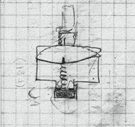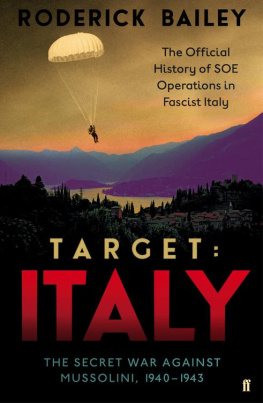This book is dedicated to Douglas Everett,
a man of stature, modesty,
kindness and tremendous enthusiasm
SOE
the scientific secrets
FREDRIC BOYCE AND DOUGLAS EVERETT
FOREWORD BY M.R.D. FOOT


Title page: The sketch in Everetts notebook showing the principle of the air leak or disc time delay Newtons hoped-for temperature independent time delay.
First published in 2003 by Sutton Publishing
The History Press
The Mill, Brimscombe Port
Stroud, Gloucestershire, GL5 2QG
www.thehistorypress.co.uk
This ebook edition first published in 2011
All rights reserved
Fredric Boyce, 2003, 2004, 2009, 2011
The Estate of Douglas H. Everett, 2003, 2004, 2009, 2011
The right of Fredric Boyce, to be identified as the Author of this work has been asserted in accordance with the Copyrights, Designs and Patents Act 1988.
This ebook is copyright material and must not be copied, reproduced, transferred, distributed, leased, licensed or publicly performed or used in any way except as specifically permitted in writing by the publishers, as allowed under the terms and conditions under which it was purchased or as strictly permitted by applicable copyright law. Any unauthorised distribution or use of this text may be a direct infringement of the authors and publishers rights, and those responsible may be liable in law accordingly.
EPUB ISBN 978 0 7524 7580 6
MOBI ISBN 978 0 7524 7579 0
Original typesetting by The History Press
CONTENTS
FOREWORD
T he history of SOE seems to spring a never-ending run of surprises: here are some more. For several years past, the Imperial War Museums secret war gallery has exhibited a set of SOEs tools some of them gruesome for forwarding its tasks of subversion and sabotage. Many of SOEs surviving papers have now gone public, and the Public Record Office has published two of the catalogues in which the tools were listed. This book explains how, why and where they were designed.
It is by two scientists, one of whom has just died his survivor dedicates the book to him; Everett served in SOE himself, and his co-author Boyce shared in the task of clearing up after it, so they write with inside knowledge, always an advantage when dealing with a secret service. They present a clear scientific account of the ways SOEs inventors worked, and summarise the results; some of them well enough known, others partly or entirely new.
There is a mass of detail, for instance, on Operation Braddock, the proposal to drop small incendiaries into Germany, to be picked up by slave labourers and used to start fires; Mackenzie mentions this in his recently released in-house history of SOE, but here it is handled fully (the results were disappointing). There is also a lot of new detail on Periwig, Templers attempt to convince the German security authorities that there was an active resistance movement in Germany in the last winter of the war; Leo Markss dark hints are here spelled out in full. SOE has often, wrongly, been accused of dealing in biological warfare; the authors are able to rebut this charge, but do have a disconcerting passage on research intended to disrupt the digestion of members of the Wehrmacht. This never reached the point of attempted action.
These pages give a vivid picture of how hard SOEs scientists worked, and how informally; they were free of many constraints of service discipline, and encouraged to think laterally. George Taylor and Tommy Davies from SOEs governing Council gave them plenty of starting impetus, and D.M. Newitt, the head of scientific research, kept all of them up to the mark.
Needless to say, he recruited on the old boy net there was no other safe way of doing so; the results justified the method. He and six of his colleagues became Fellows of the Royal Society. Inter-service and inter-secret-service jealousies marred corners of the story, and will probably be blown up by the ignorant into attempts at sensation; they did not much hinder the war effort. With the passage of time it is getting less and less easy to remember that SOE was a fighting service, formed to help win a world war.
A good deal of mud was thrown at SOE by Marxists who maintained that it was a tool of capitalism. Many of its members did come from large firms; but they were there to beat a bad enemy, not to serve any commercial interest. One of the large firms that supplied several senior men was the great textile firm of Courtaulds; and after the war Courtaulds looked after Newitt, funding a chair for him at Imperial College London.
He would have enjoyed this account of his and his colleagues role in aiding a critical victory.
M.R.D. Foot
ACKNOWLEDGEMENTS
T he authors would like to express their gratitude to the many individuals and organisations who have helped in the writing of this book. In particular, they thank Professor D.W.J. Cruickshank, FRS, for his recollections and photographs; John van Riemsdijk for supplying information and material; Elizabeth Howard-Turner for the gift of the late Agnes Kinnersleys Station IX scrap book; and Tony Brooks for his first-hand account of sabotaging railway wagons.
Duncan Stuart, the SOE Adviser to the Foreign and Commonwealth Office, was always helpful with advice and information from files prior to their official release. Christopher J. Tompkins made an excellent sectionalised drawing of the Time Pencil and Lady Cicely Mayhew translated the German on the Pigeon Post form.
Of the organisations contacted during the research for this work, the MoD Pattern Room, then in Nottingham, and the Royal Signals Museum at Blandford Camp were most helpful in permitting photographs to be made of key items of SOE equipment.
The portrait of Professor D.M. Newitt, FRS, was obtained with the assistance of the Royal Society, while the biographical details of some of the engineers were drawn from documents made available by the Institution of Mechanical Engineers.
Other organisations which contributed are the Public Record Office at Kew who never failed to come up with any of the over two hundred files consulted; the Royal Navy Submarine Museum at Gosport; the Airborne Forces Museum at Aldershot; and the Imperial War Museum whose photographic, audio and document archives were used. It is worth noting here that the IWM contains a fascinating exhibition devoted to the SOE.
Finally we would like to thank the following individuals with whom conversations have elicited numerous small but interesting points in this history: George I. Brown, Graden Carter, H. Woodend, Eric Slater, Mrs Mary Fields, Bill Mack, Tom Rae and the late Leo Marks who sadly died during the writing of this book.
The photograph of the Welbike is British Crown Copyright, 1999 Defence Evaluation and Research Agency, and is reproduced with permission of the Controller, Her (Britannic) Majestys Stationery Office.
Every effort has been made to trace copyright holders for the illustrative material contained in this book. The publishers would be grateful for additional information on any copyrighted work that is not acknowledged in these pages.
FB
DHE
PREFACE
T he history of the Special Operations Executive (SOE) and the exploits of some of its agents in Occupied Europe have been the subject of many books published in the last fifty years. As security has, little by little, been relaxed and the Public Record Office (PRO) has released previously secret material into the public domain, a clearer and more complete picture has emerged. However, despite the publication by the PRO of the
Next page











